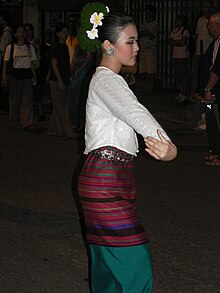Thai Yuan

Young dancer, Chiang Mai
|
|
| Total population | |
|---|---|
| (6 million) | |
| Regions with significant populations | |
| Thailand, Laos (Ban Houayxay, Bokeo Province and Sainyabuli Province) | |
| Languages | |
| Lanna (often bilingual with Central Thai) | |
| Religion | |
| Predominantly |
|
| Related ethnic groups | |
| Tai peoples |
The Northern Thai people or Tai Yuan (ไทยวน, [taj˧ ɲuːən˧]), self-designation khon mu(e)ang (ฅนเมือง, [xon˧ mɯːəŋ˧], meaning "people of the (cultivated) land" or "people of our community") are the majority population of eight provinces in northern Thailand, principally in the area of the former kingdom of Lanna. They belong to the group of Tai peoples and are closely related to Tai Lü and Tai Khün with regards to common culture, language and history. There are approximately 6 million Tai Yuan. Most of them live in Northern Thailand, with a small minority 29,442 (2005 census) living across the border in Bokeo and Sainyabuli Provinces of Laos. Their language is called Northern Thai, Lanna, or Kham Mueang.
Central Thai may call northern Thai people and their language Thai Yuan, probably derived from Sanskrit yavana meaning "stranger". In everyday speech, "Tai" prefixed to some location is understood as meaning "Tai person" of that place. The British colonial rulers in neighbouring Burma referred to them as "Siamese Shan", to distinguish them from the Shan proper, whom they called "Burmese Shan".
The people of this ethnicity refer to themselves as khon mueang, meaning "people of the (cultivated) land", "people of our community" or "society" (mueang is a central term in Tai languages having a broad meaning, essential to the social structure of Tai peoples). With this name, they historically identified themselves as the inhabitants of the alluvial plains, river valleys, and plateaus of their native area, where they lived in local communities called mueang and cultivated rice on paddy fields. This distinguished them from the indigenous peoples of the area ("hill tribes"), like the Lua', who lived in the wooded mountains practicing slash-and-burn agriculture. Membership of the ethnicity was therefore defined by lifestyle rather than by genetics. At the same time, it was a term of dissociation from the Burmese and Siamese, who held suzerainty over the Lanna Kingdom for centuries and who were not "people of our mueang".
...
Wikipedia
